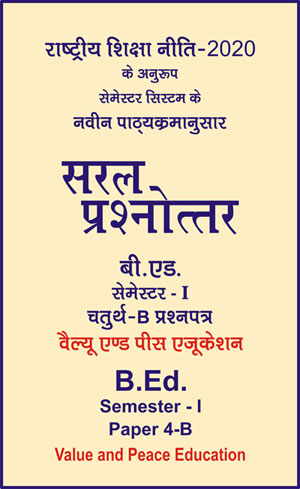|
बी एड - एम एड >> बी.एड. सेमेस्टर-1 प्रश्नपत्र-IV-B - वैल्यू एण्ड पीस एजुकेशन बी.एड. सेमेस्टर-1 प्रश्नपत्र-IV-B - वैल्यू एण्ड पीस एजुकेशनसरल प्रश्नोत्तर समूह
|
5 पाठक हैं |
||||||
बी.एड. सेमेस्टर-1 प्रश्नपत्र-IV-B - वैल्यू एण्ड पीस एजुकेशन (अंग्रेजी भाषा में)
Question- Why Moral Conflict is intractable? Discuss it in detail.
Answer -
Because of its deep-roots, moral conflicts tend to be intractable and long-lasting. Parties to such conflict often have great difficulty in describing the substantive issues in shared terms. Because they are arguing from different moral positions, they disagree about the meaning and significance of the important issues. This makes negotiation or compromise extremely difficult in and of itself.
Resolution becomes even more difficult when parties disagree not only about substantive issues, but also about which forms of conflict resolution are morally right, aesthetically preferred, and politically prudent. Parties may have very different ideas about how to gather information, arrive at a conclusion, make a decision, and deal with uncertainty.
Over the course of conflict, the original issues often become irrelevant and new causes for conflict are generated by actions within the conflict itself. This is because in moral conflict, when groups try to act consistently with what they believe is morally good and just, they “prove” to the other side that they are fools or villains. Thus, the means by which the parties seek resolution often just provoke further conflict. As the conflict continues, substantive issues are largely forgotten and "the other side’s means of dealing with the conflict is itself the force that drives the interactions among the various conflicted parties.” Thus, moral conflicts are self-sustaining.
Parties involved in moral conflict also tend to have great difficulty in imagining a win-win resolution of the conflict at hand. The substantive issues are often a matter of rigidly held moral beliefs, based in fundamental assumptions that cannot be proved wrong. These fundamental moral, religious, and personal values are not easily changed, and people who adhere to a particular ideology may very well be unwilling to compromise their world-view. Instead, as noted earlier, they may engage in diatribe, a rhetorical strategy that discredits adversaries by characterizing them as evil or morally inferior. Such characterizations often lead to subversion, repression, and violence. Because rational discourse has become useless, each party may try to force the other side into compliance. The conflict is likely to escalate and become more protracted as a result.
Also, those involved in moral conflict may regard perpetuation of the conflict as virtuous or necessary. They may derive part of their identity from being warriors or opponents of their enemy and have a stake in the continuation of the conflict because it provides them with a highly desirable role. In addition, because struggles over values often involve claims to status and power, parties may have a great stake in neutralizing, injuring or eliminating their rivals. They may view any compromise about their most cherished values as a threat to their very identity and a grave evil. Indeed, moral conflicts often stem from a desire to safeguard basic human needs such as security and social recognition of identity. On some occasions, the continuation of a conflict may seem preferable to what would have to be given up if the other party were accommodated.
Unfortunately, those enmeshed in moral conflict may be unable to discern the effects of conflict, even if those effects themselves threaten the basic human needs that were at issue. Because moral conflicts tend to be intractable and have great potential for violence, we must search for new ways to manage them.
|
|||||













